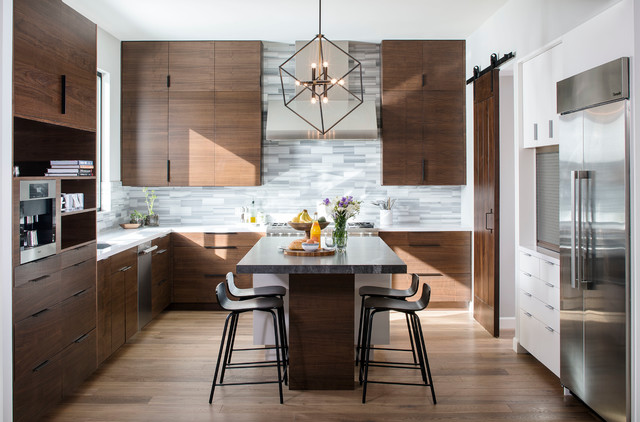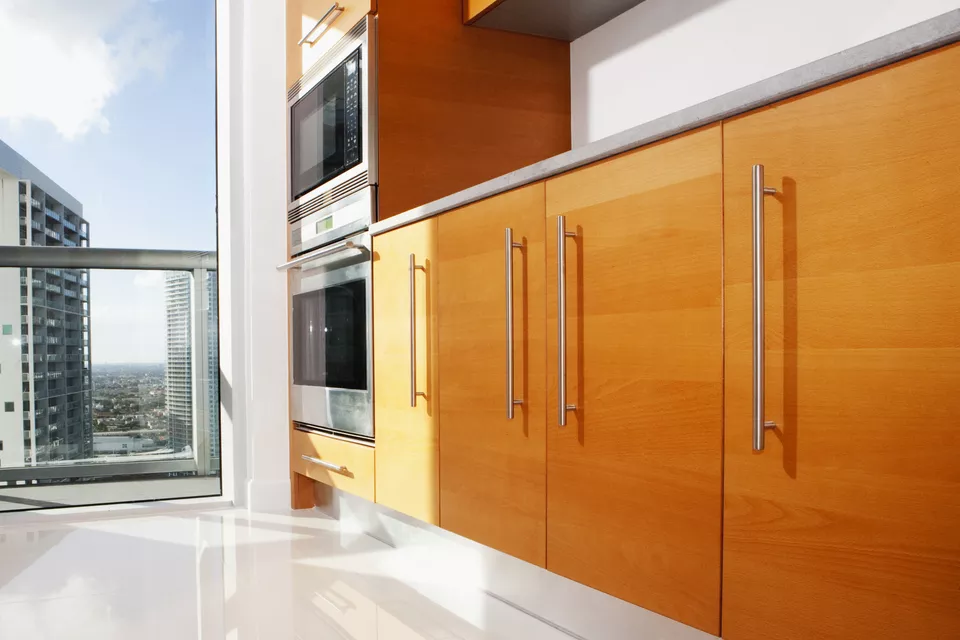When building or remodeling a kitchen, you essentially face two choices when it comes to your cabinets. That decision: frameless cabinets vs. face frame cabinets. What’s the difference?
Understanding the pros and cons for both frameless cabinets and framed cabinets is crucial. And, more importantly, the decision depends largely on your own preferences! Some people swear by the sturdy, traditional benefits of the face frame. Others still prefer the more modern, practical appeal of frameless cabinets. Read up, browse our selection, and decide what you think is best.
What’s More Popular?
Traditionally, framed cabinets are the American standard. However, the modern trend in the United States is definitely tilting toward frameless. That follows the European trend, where frameless cabinets first appeared post-World War II. The primary reason for the switch then is mostly the same as it is now: It’s more practical.
The prevailing thought these days seems to be that frameless, or “European-style,” cabinets generally age better over time. With proper installation and care, they will remain stunning for years, and will never go out of style because of their simplicity. If you’re thinking about selling your house down the road, European-style cabinets are more in demand and they can add value and eye appeal, especially during those all-important showings. And, since frameless cabinets are so simplistic, you can pair them in any room that complements them with interesting patterns, dramatic splashes of color, and other bold aesthetics. The beautiful minimalism of frameless cabinets makes them a much more versatile option than people might think.
What is the Face Frame on a Framed Cabinet?
The obvious difference is the addition of a solid wood frame, called a “face frame,” between the door and cabinet box. This frame comprises horizontal rails and vertical stiles. The frame is typically 1-1/2 inches thick, and it resembles an empty picture frame. In tandem with the wood grain of the frame itself, this face frame helps to support the cabinet box where it’s weakest: the opening.
That’s not all face frames do. Additionally, including a face frame reduces racking, which can make the cabinet box tilt out of square. If this happens, the drawers and cabinets have no chance at being level. An unsquared cabinet box means a disaster of a cabinet.
Why Framed Cabinets?
So, framed cabinets are indeed the more traditional option. They have long been a fixture in American kitchens, and they remain popular even among today’s modern homeowners. (That is changing, however.) Designers, remodelers, and installers tend to enjoy working with framed cabinets, since they are sturdier. They do provide a professional touch, too, with the amount of mounting options they provide. With a frame, mounting hardware can go inside the frame, or on the outside. Some more professional-looking framed designs actually look quite similar to the frameless product. Some basic cliff notes on the framed option:
- More common, “American-style” cabinet that’s been in production here since…forever.
- Inclusion of face frames, which allow for easier installation and, if needed, adjustments.
- Frames can be customized to any size of cabinet.
- Hardware mounting can be variable.
So, framed cabinets tend to be more durable than their frameless counterparts because of how the door is mounted: to the cabinet face, instead of directly into the cabinet box. It’s an added degree of wear and tear in frameless cabinets that framed ones don’t have.
And, we mentioned racking earlier. It’s less of an issue with framed cabinets because, as noted, the frame offers support to keep everything level and upright. Probably the most common reason people give when they explain their choice of framed cabinets is sturdiness–less sloping, less unevenness. This is a particularly important issue if your home is prone to earthquakes, which can disrupt less-stable cabinet construction.
Before we take a deep dive into the benefits of frameless cabinets, it’s important to clarify what sets them apart from their frameless counterparts. By definition, frameless cabinets rather obviously do not have a frame attached to the cabinet box. The cabinet instead is flush with the box, providing a more minimalist, modern appearance. On frameless cabinets, the door itself is the face frame for the cabinet. On framed cabinets, which include a built-in frame, the hinges attach the door to the face frame. On frameless cabinets, the cabinet hinge attaches directly to the box.
Why Frameless Cabinets?
Frameless cabinets are exactly what they sound like. They’re a cabinet box with two sides, a back, and a top and bottom. This design allows them to be flexible, as the installer can put them in either way; technically, there is no real “top” or “bottom.” This versatility causes many to refer to frameless cabinets as universal or full-access. Without a front border for the attachment of doors, the box is easier to get into (especially key in places where plumbing is hidden). The only doors for these cabinets are full overlay doors, which have door hinges attached directly to the cabinet box sides.
So, what’s to like? They’re more modern and streamlined, to be sure–sleek, even. The lack of a frame allows for easier access to the contents of the cabinet box. And the versatility and flexibility of frameless cabinets mean that they are right at home in any situation. To summarize going frameless:
- Sleeker, more modern look that better achieves European-inspired style.
- Lack of a face frame means easy access to the cabinet interior, and larger box space.
- Cabinet sides are ordered finished at the factory.
- Not as versatile as framed–fewer options in sizes and mounting solutions.
Side-by-Side Comparison
When looking at frameless cabinets and face frame cabinets side by side to decide which to pick, a few advantages and disadvantages jump out. For starters, there’s cost. While there is not a massive difference between the two options, there is a difference. Frameless cabinets, since they have no face frame, require less material. Naturally, that means that they are more affordable to buy than their framed counterparts. As mentioned earlier, it is possible for installers to make framed cabinets that look frameless. They can still have the full overlay that frameless ones have. Usually, though, this simply increases the price even further.
Second of all, the primary purpose of a cabinet is storage, right? You simply get more space when you go frameless. Why? Because frameless cabinets don’t have a center stile (that big block of wood divider that splits the cabinet doors). This means that without a frame, you’ve got a wide-open space to work with. If you’ve ever had to get under your sink and into your cabinet with a monkey wrench, you know how precious real estate is inside your cabinets. Removing the frame and center stile means an obvious storage space advantage for the frameless option. It might only be a couple of inches of space, but that couple of inches makes a huge difference. When it comes to full cabinet access, frameless is the clear winner.
The third comparison you’ll want to make is less about utility and much more about your own personal tastes. Are you a traditionalist, or do you like sleek and modern looks more? Is your kitchen going to have a trendier more European feel, or is classic American more your style? If modern simplicity is your preference, then there is no doubt that you’ll much prefer the seamless look of frameless cabinets in the kitchen. Simple, simple, simple. However, if you like the versatility a frame face has to offer when it comes to cabinet styles or mounting options, you can’t go wrong with framed.

Styles of Frameless Cabinets
Many people think that because frameless cabinets don’t have the face frame, they won’t provide any style. That’s just not true! They are actually available in many various styles, and most are fully customizable. Check out our selection, as an example. In particular, customizable hinges will let you get quite precise with how far the cabinet can open. The point is, “frameless” doesn’t mean “option-less.”
One more consideration to make is your climate. If you live where it is particularly cold, humid, or hot, you should probably opt for frameless. Why? Because in extreme climates, wood frames can shrink or swell with the weather. That means sticky drawers in the summer, or ones that rattle around in colder weather. If your climate is more mild or moderate, this probably won’t be a major concern to you. Just be aware that it’s in the range of outcomes if you go with a face frame.
Are Frameless Cabinets A Good Option For You?
At the end of the day, it’s your kitchen, and what matters most is what your preferences are and what look you are trying to accomplish. Take the time to look at lots of cabinets, both framed and frameless, to see which style strikes you better. Framed cabinets are beneficial for kitchens with lots of cabinet space where extra room isn’t always in high demand. They are also the best option for people who like a traditional look, decorative hinges, or flexibility for door options.
Frames are also great if you want to keep hinges out of sight through glass cabinets. Frameless cabinets are probably the way to go in smaller kitchens, where cabinet space is at a premium and every square inch means so much more. They provide a modern look, they give you more space in your drawers and cabinets, and of course, there are no center stiles to get in your way. And, it’s the most obviously impactful way to embrace the fully European kitchen.
So, now that you’ve learned more about the differences between frameless and framed cabinets, which would you choose?






